The Polytechnic Legacy
for the ASME Management Training Workshop, Sheraton Dallas Brookhollow Hotel, Dallas TX,
9:30 AM, Saturday, August 22, 1998
by John H. Lienhard
Mechanical Engineering Department
University of Houston
Houston, TX 77204-4792
jhl [at] uh.edu (jhl[at]uh[dot]edu)
Every now and then, it's worth any group's time to take stock of who they are and where they came from. So, who are we and where did we come from? Who are we who've been calling ourselves engineers since the early 19th century?
Actually, so much of who we are and what we do traces to what I call The Legacy of the Polytechnic Institute. To explain that, I first need to play with the word engineer. Engineers have been around a long time. Whoever organized construction of the Great Pyramid five thousand years ago richly deserves to be called an engineer. But the term engineer has been generally used only since people started learning how to build things in universities. Before that, most of the great inventors and builders did their work without formal education. Young James Watt spent a year in London as an apprentice instrument maker. The rest he had to get from conversation, reading, or his own invention. But as we trace the etymology of the word engineer, we find that it's grown up around the formation of schools meant to teach us how to make things.
The word engineering probably derives from the Latin word ingeniatorum. In 1325 a contriver of siege towers was called by the Norman word engynours. By 1420 the English were calling a trickster an yngynore. By 1592 we find the word enginer being given to a designer of phrases — a wordsmith. The Oxford English Dictionary gets to the first use of the modern word engineer in 1635, but you might not be crazy about its use. Someone is quoted as calling the devil — "that great engineer, Satan."
Down through the 17th century, variations like Enginer, Ingenier, and Engyner pop up. More and more often those words are applied to builders and makers of things. Finally, in 1787, the English Army had a Corps of Engineers and, five years later, a Society of Civil Engineers.
By the mid-1600s, artillery and fortifications had grown so complex that armies began training officers in math and mechanics. That's what gradually turned into civil engineering. In 1775 King Louis XV of France authorized Jean Perronet to set up a School of Bridges and Highways with a three-year program.
After the chaos of the French Revolution, Napoleon decided he needed to start over. In 1794 he replaced Perronet's school with the École Polytechnique, and the game changed. The École Polytechnique hosted the greatest mathematicians and theoretical mechanicians of that age — Biot, Arago, Fourier, all names that we engineers know very well.
And that word Polytechnique has stuck. MIT, Rensselaer, Cal Tech., Georgia Tech — they all use it in its English form. For me, the Brooklyn Polytechnic Institute will always call to my mind one of their graduates, an engineer named A. J. Cohen. A.J. and I shared an army barracks at Fort Monmouth back in 1954. A.J., or Ajax, as we called him, was pure Brooklyn of the old school — in speech, in manner. Naturally, he made a lousy soldier, and that endeared him to the rest of us. We were all engineers who hated being trapped in a peacetime army for two years.
Ajax was pure lower-income city boy. He came out of a crowded, rabbit-warren project apartment. He'd never even driven a car. He was unregimentable — totally out of place in a uniform. And his pervasive good humor made a fine mockery of the military around him. Ajax was, for me, the Polytechnic Tradition transmuted. In a moment, I'll show you why. But first we must trace the École Polytechnique legacy in America.
That idea almost immediately burst into America. As early as 1795 a crude form of military engineering was being taught in the town of West Point — even before the military academy was set up there. In 1819 West Point began modeling itself on the École Polytechnique. Rensselaer Polytechnic Institute offered civil engineering by 1828, and the University of Virginia by 1833. Norwich University was probably in the game even earlier. All those schools looked to France for guidance.
And, as I look at old photos from those first engineering schools, I see something I like. It's formality — formality of dress, behavior: An old professor lectures in a black frock coat; surveying students stand outside their tent in vests and hats; students at the blackboard work exercises with formal sketches and neat solutions.
I must be the last dinosaur to wear neckties in class. I do it to honor the process, like going to church. That necktie makes me neither a better teacher nor a more devout worshiper. But it does say I'm doing something I value. By now, I've been teaching engineering for one fourth of the time the field has existed. I suppose it's no wonder I feel such love for those stiff images of students and teachers, once so serious and intent.
Anyway, back to France's great École Polytechnique: Two years before he imposed a military dictatorship on France, Napoleon Bonaparte was the twenty-eight-year-old head of the French army. That year, 1797, the Institute of France made him a member of her Scientific Division. Napoleon's being honored for contributions to science catches us by surprise. But the award acknowledged the young Napoleon's important work in strengthening the École Polytechnique.
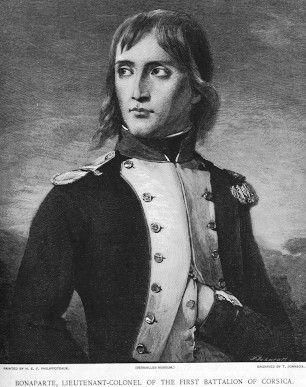
From the January 1895 Century Magazine
The Young Napoleon Bonaparte
In 1798, a year after that honor, he made his Egyptian campaign into a scientific mission as much as a military one. It was during his military stalemate in Egypt that one of his archaeologists discovered the Rosetta stone.
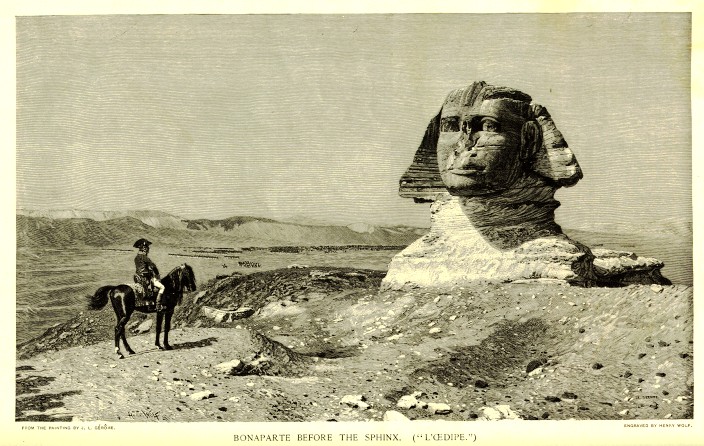
From the 1895 Century Magazine
Napoleon's support for the applied sciences soon got mixed up with a fixation on architectural monuments. In 1804, the same year he allowed himself to be declared emperor, he wrote, "Men are only as large as the monuments they leave." He dreamt of building monuments from his military spoils — of melting cannon into heroic structures in iron to celebrate battles won. He was still interested in engineering, but that interest had turned to his own glory.
The snag in Napoleon's dream of immortalization in iron was that working with iron takes a great deal of expertise. England had mastered ironwork, but France lagged far behind. English iron was expensive, and the quality of French iron was poor. France was still smelting iron with charcoal instead of coke. Her engineers had not yet learned the subtleties of building with iron.
Napoleon's new breed of French engineers was eager and surprisingly well prepared to take up the challenge; but French architects were consummate artists in granite. They wanted nothing to do with iron.
During Napoleon's reign as emperor his engineers and architects did execute some major works in iron. They built several bridges with varying success. Once they got the hang of it, the French built a 106-foot arch over the Seine River and named it after the Battle of Austerlitz.
The toughest job was using iron to replace a 129-foot dome over a circular grain exchange, theHalle aux blés. That was finished just two years before Waterloo at seven times the original cost estimate.
France by no means caught up with England during Napoleon's reign. She had too far to go. France eventually built both the Eiffel Tower and the Statue of Liberty using iron, but that was seventy years after Napoleon. When all is said and done, Napoleon probably did start France on its way to iron construction.
What Napoleon gave technology could never have sprung from a craving for monuments. The young, idealistic Napoleon laid a foundation for engineering education. In the end, what he gave us was the antimilitary Ajax Cohen. He gave us the people who really do build our world.
The École opened toward the end of a century that'd radiated a peculiar genius. The 18th century had given us people like Mozart, Jefferson, Euler, and Ben Franklin. Isaac Newton led us into the astonishing 18th century. And the last of those giants were ones who passed through the École's doors. Let's go back and meet Jean Baptiste Joseph Fourier.
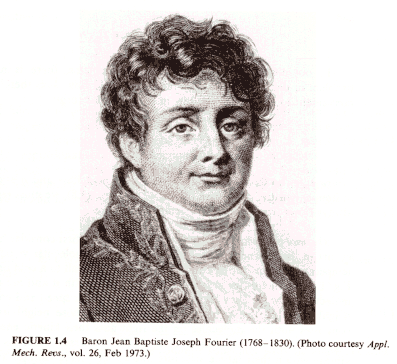
Anyone who has studied mathematics, heat flow, or acoustics has encountered Fourier. Fourier was born in France in 1768. He trained in mathematics and military engineering. Then he got caught up in the politics of the French Revolution. He was a revolutionary, but other revolutionaries jailed him when he defended victims of the Reign of Terror. When Fourier, now 27, took a faculty post at the École Polytechnique in 1795, his politics followed him, and he was jailed again. A colleague finally took him out of harm's way by arranging a foreign post for him with a general even younger than he was. In 1798, Fourier went off to Egypt with Napoleon.
Napoleon made Fourier secretary of the newly formed Institute of Egypt. Fourier did high-level administration during the Egypt campaign. Then, when Napoleon returned as the leader of France, he sent Fourier to Grenoble to serve as the Prefect of Isère, something like the governor of an American state. Fourier brought astonishing energy to the task. He built roads and engineered land drainage. He wrote papers on mechanics and a book on Egypt. He finally resigned his post in 1815 to avoid being entangled in Napoleon's abortive return from exile and went back to research.
Fourier had started thinking about heat flow in Egypt. While he was in Isère he submitted a paper entitled The Analytical Theory of Heat to the Academy of Science. In that paper he showed how to describe heat flow in solid bodies. But he did much more than that. He also created the whole field of modern linear analysis.
Like most real masterpieces, the paper broke rules. Fourier's intuition led where his logic couldn't always follow. He offended many great mathematicians. Fifteen years passed before the work was finally published in 1822. By then it was a full book and the most important mathematical work of that age.
The Egypt adventure touched Fourier's entire life. It began a lifelong obsession with heat and with its healing powers. In his later years he swathed himself, mummy-like, in his overheated Paris apartment. At the end, he died of a chronic illness he'd contracted in Egypt. But, by then, Fourier had permanently altered the very character of engineering. France was now training a whole new generation in applied analysis. Let me tell you about an especially surprising case:
The names of 72 important scholars who founded the science and mathematics of structures are written in the Eiffel Tower. Lots of them learned their business at the École Polytechnique. But I want to tell about a name that isn't there. It is Sophie Germain, and she certainly belongs on the list. Sophie Germain was born into a well-to-do Parisian family in 1776 — born into a world that was still hostile to bright women. And she was bright.
Sophie was thirteen when the French stormed the Bastille, and her parents put her under virtual house arrest to keep her from the dangers of those stormy times. She went off into the large family library and began to teach herself mathematics — much to her parent's alarm. They tried to keep her from it by removing the heat and clothing from her bedroom. When they found her wrapped in bedclothes among stolen candles, calculations, and a frozen inkwell, they wisely gave in. Sophie spent the Reign of Terror studying calculus.
Of course she belonged in the École Polytechnique. But the École didn't admit women. No university did. So she learned by studying other people's class notes. When she started doing original work, she hid her femininity behind the alias, M. LeBlanc. She used that name to correspond with two extraordinary mathematicians — first with LaGrange, then with Gauss.
They were both quite taken with her work and they encouraged her — even after they found out who she really was. Then, in 1811, she made the first of three assaults on a standing prize offered by the Academy of Sciences. The problem was to describe the vibration of an elastic plate (like the top of a violin or a flat structural member.) Her first effort netted her only gentle criticism from LaGrange. Her second try, two years later, won an Honorable Mention. Then, in 1816, she won the Grand Prix. Suddenly, at thirty, she was accepted into the company of the great applied mathematicians of all time: Navier, Poisson, Fourier, Ampère, Legendre, names every engineer knows today.
She did a lot during the next 15 years, particularly in the mathematics used to design structures like the Eiffel Tower. She also worked in pure number theory. Then, in 1831, Gauss arranged for her to receive an honorary doctorate at Göttingen University. She spent that spring working in terrible pain with breast cancer. She was only 45 when she died that June — too soon to actually meet Gauss, too soon to go to Göttingen, and too soon to receive the recognition that was her due.
Paris was Science-City in those days. For outsiders like Sophie Germain and insiders alike, the École was the hub. Here's another telling story to think about. This one begins in 1804, in a salon in the French countryside. The guest is Joseph Gay-Lussac. Gay-Lussac is a brilliant young chemist, only 26 and a junior faculty member at the Ecole. He's just made a series of heroic balloon ascents. He's been measuring the atmosphere with instruments of his own invention. He's gone as high as 23,000 feet with no breathing apparatus.
Also in the room is Friedrich von Humboldt, 35. Humboldt is a well-known scientific generalist. He's with the German diplomatic mission in Paris. Humboldt has worked in geography, astronomy, and atmospheric studies. In a few years he'll do the basic exploration of the northern part of South America.
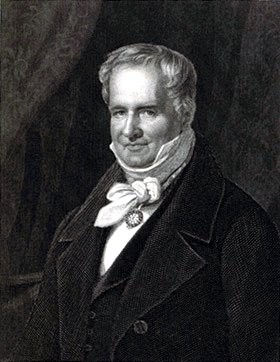
19th century engraving courtesy of Special Collections, UH Library
Baron Alexander von Humboldt
The problem is that Gay-Lussac had recently found flaws in Humboldt's atmospheric work. He'd savaged it in print. Now the two meet for the first time and Humboldt does a remarkable thing for those aggressive times: He swallows his hurt. He congratulates Gay-Lussac on his balloon ascents. He offers the hand of friendship. That remarkable gesture isn't lost on Gay-Lussac. And so begins a lifelong cooperation.
When Humboldt returned from South America in 1809, and from subsequent meetings with Thomas Jefferson, he found lodgings with the third and youngest member of this remarkable trio: François Arago. Arago was a twenty-three-year-old astronomy professor at the École.
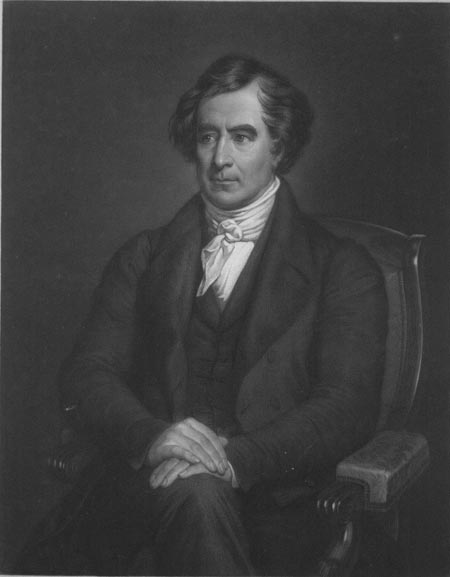
François Arago
Arago and Gay-Lussac were old friends. It's Arago who reported Humboldt's unexpected act of trust. It's his writings that reveal the values that the three of them shared for fifty years. Arago, Gay-Lussac, and Humboldt all wrote voluminously. All assumed statesmanlike roles that reshaped European science. They represented a new fusion of Industrial Revolution technology with the ivory tower of French theory.
They brought a new social conscience to scientific technology. Arago fought scientific elitism. He also fought the French slave trade.
Humboldt's writings drew the scattered 19th-century sciences together. He too fought for social justice. Before the Civil War, he wrote acidly about slavery in America. He said that our talk about freedom seemed to be little more than a means in the pursuit of profit.
And Gay-Lussac became a great teacher. He had a most profound influence on science when a young German named von Liebig came to study with him. Gay-Lussac opened the youth's eyes to a whole new view of science. Back in Germany, Liebig used Gay-Lussac's ideas to create the first modern R & D lab.
So three friends helped to shape the science that rose out of 18th-century revolution. And all that defined the influence of the École Polytechnique. It also defined the values of the engineering you represent today. But it also traced to an act of simple courtesy between Humboldt and Gay-Lussac, celebrated by Arago. In 1804, the outbound ripple from a small act of human decency changed science. And it changed history.
Now move forward to 1834. By now François Arago has become a ranking French scholar, and he rises to address the French Academy of Sciences. By now, he's worked in astronomy, then in optics and electricity. He's helped prove that light moves in waves. He's measured the speed of sound in ice. He's worked on the polarization of light. His electrical work anticipated Faraday.
But Arago has also been looking beyond science toward its use. His work on electricity has found use in telegraph systems. He's taken part in studies of steam boiler explosions. In his mid-40s he went a step further; he took up politics. His verve and charisma won such liberal causes as abolishing slavery in French colonies and improving conditions for sailors.
Now Arago rises to take on another radical cause. The theoretical French have let their industry fall far behind the practical English. The French look at England the way we started looking at Japan in the 1980s. Arago's lecture is one the French Academy is not ready to hear. It's about England's James Watt. He starts by acknowledging two French thinkers who had the idea of a steam engine. But, he says, it took the English to put flesh and blood on the idea.
The English built the actual engines. The only science that helped them was the science of their own shrewd observations. And, he adds, those engines have improved the life of the poor. With that he's gone too far. French intellectuals preferred to see English machines as evil. Arago faces an angry outcry.
Soon after, he wrote a second paper to defend himself. He titled it, On Machinery Considered in Relation to the Prosperity of the Working Classes. It says things most of us take for granted: Machines don't steal jobs, they create them. Machines make goods affordable to the poor. And so on.
By now, of course, the new engines really had become monsters. Four years after Arago's talk, Charles Dickens published Oliver Twist. Dickens woke the English public to the horrors of industrial slums. And a new wave of social reform had to begin.
But Arago celebrated the humanitarian impulse that drove people like James Watt in the first place. Watt really did create machines in the interests of the common people of whom he was one. And which of us would exchange our everyday lives today for the lives we lived before Watt — or before Arago.
And I find myself back to Ajax Cohen, that archetypical everyman in the U.S. Army. There was nothing remotely aristocratic in Ajax, the ultimate iconoclast out of lower class Brooklyn! America took the Polytechnic tradition and stirred it in with a new doctrine of egalitarianism. For we were determined to use education as a social leveler. In that I believe that we've ennobled the French idea just as Arago would've wanted it ennobled.
Of course I haven't begun a proper roll call of people who studied and taught at the École Polytechnique — Carnot, Lagrange, Laplace who studied at Jean Perronet's precursor of the École Polytechnique — the École Militaire. But that would reduce greatness to tedium, and I don't want to do that. I'll finish today with the way all this played into the American Society of mechanical Engineers. And for that we must first go to Brown University.
Brown was a Baptist college formed in the 18th century. It stayed Baptist until well into the 20th century. Until 1836 Brown gave only a classical bachelor's degree, heavy with subjects like Greek and Hebrew. But pressures to serve a larger public in our new republic were strong. In 1850 Brown joined those pioneering American schools with its own engineering degree, also shaped in the tradition of the École Polytechnique. To head the degree, Brown imported a new professor, William Norton, from West Point.
In that first engineering class was a young man named Lyman Holley. In 1859 another brilliant young man named Robert Thurston also completed the new degree. Those two, of course, were the key players in shaping our ASME.
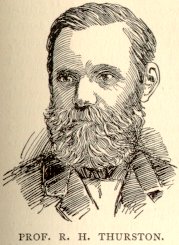
From the 1897 Encyclopaedia Britannica
After doing distinguished work on the new Bessemer steel process, Holley, now 48, was instrumental in forming the ASME. And Thurston, who was born five years after Arago's speech to the French Academy, left Brown to work in his father's machine shops. After the Civil War, he taught engineering — first at Annapolis and then at Stevens institute.
By 1885 he'd done fundamental work on engineering standards of all kinds. That year, at the age of 46, he took over the Sibley School at Cornell and created what was probably the finest engineering school in America. But, while he was still only 41, Thurston was elected the first president of ASME.
And it really is no coincidence that, today, the one engineering accomplishment for which Thurston is best remembered is his translation of Carnot's paper on the motive power of heat. In that paper, the 28-year-old graduate of the École Polytechnique set down the foundations of the Second Law of Thermodynamics.
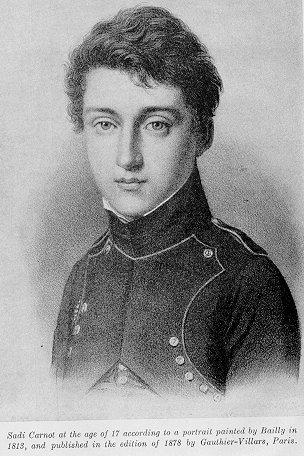
In his translation (which stands today as the best we have) Thurston cemented the link between the École and the American Society of Mechanical Engineers. I began by saying that we should remember who we are and where we came from. Well, we did come out of Napoleon's new engineering school.
But we re-engineered that school to serve a new kind of country. Now the A.J. Cohens of the world would study the means by which to build the new republic.
And that is just exactly what did happen.
SOME SOURCES
Grayson, L. E., The Making of an Engineer: An Illustrated History of Engineering Education in the United States and Canada, New York: John Wiley & Sons, Inc. 1993.
Steiner, F. H., Building with Iron: A Napoleonic Controversy. Technology and Culture, Vol. 22, No. 4, October, 1981, pp. 700-724.
Osen, L.M., Women in Mathematics. Cambridge, Mass.: MIT Press, 1974, pp. 83-93.
Arago, M., Life of James Watt. 2nd ed., Edinburgh: Adam & Charles Black, 1839. (M. must stand for Monsieur. Arago's initials were D. F. J. This volume also includes Arago's rejoinder, "On Machinery Considered ...," Lord Jeffrey's Elogium of James Watt from the Encyclopaedia Britannica, and Lord Brougham's "Historical Account of the Composition of Water." (In 1905, the American visionary, Andrew Carnegie, also wrote a biography of James Watt. He made several references to Arago's important lecture.)
Biermann, K-R., Humboldt, Friedrich Wilhelm Heinrich Alexander von. Dictionary of Scientific Biography, Vol. ??, (C. C. Gilespie, ed.) Chas. Scribner's Sons, 1970-1980. pp. 549-555.
Arago, D. F. J., Joseph Louis Gay-Lussac. The Golden Age of Science: Thirty Portraits of the Giants of 19th-Century Science by Their Scientific Contemporaries, (Bessie Zaban Jones, ed.), New York: Simon and Schuster, 1966, pp. 187-216. (The Arago biographies of Volta, Laplace, and Herschel in this same volume do much to explain Arago's important place as a scientific observer.)
Fourier, J., The Analytical Theory of Heat (translated by A. Freeman). New York: Dover Publishers, Inc., 1955.
Gratton-Guiness, I., Joseph Fourier 1768-1830 (with J. R. Ravetz). Cambridge: MIT Press, 1979.
Mitchell, M., Encyclopedia Brunoniana, Providence, R.I.: Brown University Library, 1883.
See also articles on Holley and Thurston in the 1897 Encyclopaedia Britannica.
Carnot, S., Reflections on the Motive Power of Heat. (tr. from the French, Réflexions sur la Puissance Motrice du Feu et sur les Machines Propres à Développer Cette Puissance, by R. Thurston) New York: ASME, 1943 reprint. (The title page of the 1824 first edition identifies Carnot as "ancien élève de l'École Polytechnique.")
For more on the many people mentioned here and for much of the subject matter, check the SEARCH and KEYWORDS functions on the Engines website, http://www.uh.edu/engines